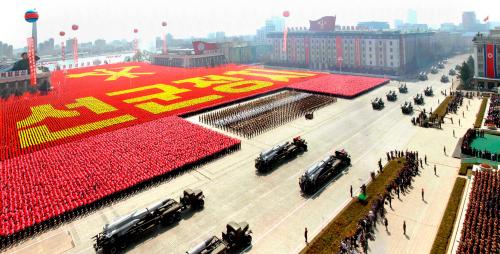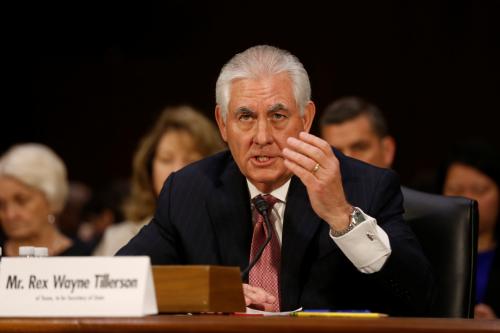The new administration faces the challenge of actually formulating and conducting foreign and national security policy towards Asia. In particular, it will behoove the Trump administration to understand and take Asian opinions, like those presented in the Asian Barometer Survey, into account when formulating its policies. The Brookings Institution convened an event last September at which scholars associated with the Asian Barometer Survey presented their findings.
The people of Asia did not get to cast a ballot in the recent American presidential election. They may have wanted to, for the simple reason that any U.S. administration’s policies have a great impact on their welfare and security. Asians did watch the campaign with a combination of fascination and dread. Japanese and Koreans were concerned about Donald Trump’s statements on the future of their alliances, while some Chinese found Trump’s image as a decisive deal maker appealing.
The new administration now faces the challenge of actually formulating and conducting foreign and national security policy towards Asia. And, even though Asians may not have had a vote in the election, they and their governments will have a voice when it comes to the Trump administration policies that affect their interests. Because it will behoove the new administration to take Asian opinions into account when formulating its policies, knowing those opinions will be an important point of departure.
Fortunately, there are public-opinion surveys available that provide U.S. policymakers a baseline of Asian views. One of those is a series of polls conducted by the Asian Barometer Survey in 10 Asian countries, most recently from June 2014 to June 2016. They did not focus on policy, and if they had the results probably would have been overtaken by the events of the American campaign. But they did seek to gauge how Asians in different countries view the United States. They also measured views of China, which become important since the game in Asia today is increasingly a competition for influence between Washington and Beijing.
So what do the results of the Asian Barometer Survey tell us?
The good news for the United States, first of all, is that it was well regarded in many countries of East Asia. In most countries, the public has a strongly positive view of the regional impact of the United States:
| Philippines | 92% |
| Vietnam | 90% |
| Myanmar | 86% |
| Cambodia | 85% |
| Korea | 83% |
| Mongolia | 80% |
| Singapore | 80% |
| Japan | 79% |
| Thailand | 75% |
| Taiwan | 73% |
| Hong Kong | 55% |
| Malaysia | 50% |
| Indonesia | 45% |
| Data source: ABS Wave IV (2014-2016) | |
Only Malaysia and Indonesia come in less than 70 percent: 50 percent for Malaysia and 45 percent for Indonesia.
TAKEAWAY ONE
The new administration begins with a reservoir of goodwill in most of East Asia. The 2016 campaign may have diminished this positive view only somewhat, but even so it should not be taken for granted. Hippocrates is relevant here: do no harm.
TAKEAWAY TWO
Donald Trump’s anti-Muslim rhetoric during the 2016 campaign probably did the worst damage to the American image in the places where the United States can least afford it: Malaysia and Indonesia. Here, a special repair effort is in order.
Second, perceptions of U.S. influence relative to that of China are not good. In the 2014 to 2016 surveys, the Philippines was the only country where a majority of those questioned believed that America had the most regional influence at that time. Regarding other treaty allies, only 27 percent of the Japanese surveyed and 25 percent of Koreans thought that the United States had the greatest influence.
At the same time, East Asians regarded China’s influence as relatively high. Over a majority of respondents in Japan, Korea, Mongolia, Taiwan, Singapore, Vietnam, Myanmar, and China itself thought that China had the most influence in the region. Close to half in Thailand and Malaysia thought the same way. Whether these perceptions are correct or not, their very existence becomes a reality and should have an impact on the Trump administration’s policy decisions.
| Which country has the most influence in Asia now? | ||
| China | United States | |
| Vietnam | 60% | 18% |
| Taiwan | 61% | 22% |
| Mongolia | 61% | 9% |
| Japan | 61% | 27% |
| Singapore | 54% | 29% |
| China | 58% | 28% |
| Korea | 67% | 25% |
| Thailand | 49% | 19% |
| Malaysia | 42% | 46% |
| Cambodia | 27% | 46% |
| Indonesia | 37% | 37% |
| Philippines | 22% | 59% |
| Myanmar | 57% | 32% |
| Data source: ABS Wave IV (2014-2016) | ||
TAKEAWAY THREE
If the new administration does conclude that it’s in the interest of the United States to play an active political, economic, and security role in East Asia—for its own sake and vis-à-vis China—it will have to mobilize resources to reverse the tendency of East Asians to think that, in effect, the balance of influence has shifted from the United States to China. In this regard, a decision to withdraw from the Trans-Pacific Partnership (TPP) would only strengthen this impression of American decline and withdrawal from the region.
Additionally, should the incoming administration choose to step up the American game in Asia and so change Asian perceptions of its influence, it will have to do so skillfully. All these countries are dependent on China economically, and therefore none would agree to be part of an effort to contain China. And, for better or for worse, they will always be China’s neighbors, so they must proceed cautiously.
Third, several factors seem to shape East Asian opinion regarding China and the United States. Specifically, people tend to be comfortable with China’s revival as a great power if:
- They live in less democratic political systems;
- They believe that their economies are doing well; and
- Their economies are not too dependent on China.
Conversely, more democratic countries with economies that are weak and dependent on China tend to have a more positive view of the United States.
TAKEAWAY FOUR
The United States will improve its image in Asia if it is able to improve its currently dysfunctional democratic system, and if it can serve as an economic alternative to China. Here again, what the new administration does concerning TPP will be important.
Finally, there are findings on how people who live in China view their own system vis-à-vis that of the United States:
- Those who believe that the United States is the more democratic country favor the U.S. system, and vice versa;
- People who have higher life satisfaction prefer the China model;
- Those with more education, most likely within the Chinese education system, prefer the China model; and
- The Chinese media appears to create a preference for the Singapore model of economic prosperity: an uncorrupt and well performing government, and a political system that is freer than China’s but less free than America’s.
The incoming Trump administration has sent a variety of signals that it will confront China over an array of issues. Whatever the merits of such an approach, it does not in and of itself constitute an Asia-Pacific strategy. China’s neighbors, some of whom are U.S. treaty allies, have a stake in U.S. policy and deserve to be closely consulted. In addition, any effort to preserve U.S. influence in Asia should take into account the views of people in the region, as manifested in the findings of the Asian Barometer Survey and those of other efforts.
The Brookings Institution is committed to quality, independence, and impact.
We are supported by a diverse array of funders. In line with our values and policies, each Brookings publication represents the sole views of its author(s).










Commentary
How Asians view America (and China)
January 18, 2017